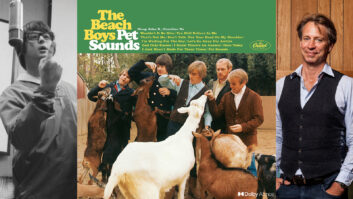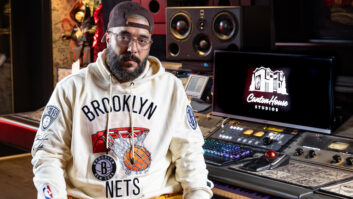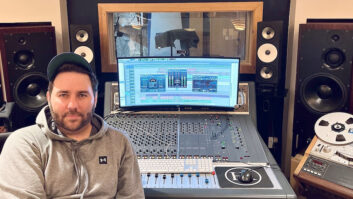The act of taking a song’s vocal tracks and putting them to a new arrangement that targets the dance music market is a serious craft. Remixing has come a long way over the past decade. This is due, in no small part, to advancements in music-making technology, especially computers and software. In the past, only songs that were at, or near, a dance tempo were good candidates for remixing. Today, the vocals from practically any song, regardless of its original tempo, can be massaged and manipulated.
Remixes have become a staple of today’s music industry economy. They are now used regularly to promote artists, even when an artist’s genre isn’t dance. And, there is little doubt that remixes are fueling dance music’s popularity. (Disco lives.) However, as with most disciplines, simply buying the latest remixing gear won’t turn you into a hotshot remixer overnight. Remixing requires its own brand of production smarts and familiarity with the dance music movement. In order to uncover some of this know-how, Mix sought out several of the industry’s top remix producers — Brian Transeau (aka BT), Dave Audé, and Chris Cox and Barry Harris of Thunderpuss — and asked them to share their insights.
FIRE STARTERS
All four remixers employ Macintosh G4 computers, a digital audio sequencing application, and software for time-correcting vocal and instrument tracks. And, while G4s are used in the studio, Apple’s Titanium Powerbooks are popular for composing on the road. BT also uses a PC for additional sound-design duties, such as taking advantage of synthesis programs that are only available for that platform. Audé does all of his recording and editing in Digidesign’s Pro Tools, Cox and Harris depend on MOTU’s Digital Performer, and BT uses both Pro Tools and Emagic’s Logic Audio.
“I work in Pro Tools, especially when I’m scoring film, in order to deliver stems in that format,” BT says. “But for my next album, I have actually written several songs completely in Pro Tools. It’s weird, because I don’t usually do that; I mostly compose in Logic Audio.”
Software synths are slowly making their way into everyone’s arsenals. Cox and Harris have even used Propellerhead’s Reason on a few recent projects. But at the same time, the consensus still seems to be that hardware-based synths sound the best. A cursory look around each of the remixers’ studios shows that they are well-stocked with Waldorf, Access (like the Virus), Clavia (specifically, the Nord Lead) and Roland equipment. As Audé explains, “In terms of turning something on right now, twisting a few knobs and getting a nice big, warm sound, keyboards and sound modules are still the way to go.”
Effects plug-ins get the thumbs up all around. Audé and BT are heavily invested in TDM plug-ins, and the Bomb Factory and TC Works products are big favorites. Cox and Harris also like the Bomb Factory plug-ins, but they use the MAS versions for compatibility with Digital Performer. “Bomb Factory plug-ins are a must; the compressors and other effects are wonderful,” Cox says, adding, “The built-in Digital Performer plug-ins are really great. We haven’t had to get into VST wrappers because the plug-ins that come with Digital Performer are so strong. Audio Ease plug-ins, like the Nautilis bundle, are also cool.”
Mixing consoles are an interesting case study with this group. Audé owns a Mackie Digital 8•Bus but doesn’t use it much. BT has a console-less setup, using Digidesign’s Pro Control to interface with Pro Tools. Both Audé and BT record directly to Pro Tools through stand-alone mic pre’s and Digidesign’s 888|24 interfaces. They even mix down directly to hard disk, right off of the stereo bus of their digital audio sequencer’s virtual mixer. In contrast, Cox and Harris own three Mackie analog 8-bus boards. They keep mixes going in each room, zeroing a board only after the mix has been approved and “signed off on,” Cox says. “We use the Mackie 8•Bus consoles because they sound great, we’re very happy with the results and we’re fast on them. People like the way our records sound, but then they see how we’re doing it and are horrified. It’s pretty ghetto, sort of a bedroom studio moved into a bigger room. However, a lot of the character of dance music is a little rough around the edges; we’re not trying to make a jazz or classical record here.”
REMIX KINDLING
These remixers are adamant that before they accept a job, they must like the material to be remixed. BT explains, “I will only do a remix for a band whose work I love, and I have to love the song and feel that I can add something to it.” Harris adds, “Some songs just weren’t written to be at a dance tempo. Like the Nelly Furtado song, ‘Turn Off the Light’ — that’s a hook that’s meant to be performed at that tempo. Don’t ruin it by changing its tempo [sings the hook slowly to demonstrate his point] — that sounds horrid to me. Changing a hook like that messes with the integrity of the original song. Yes, anything can be made to fit to any tempo, but we’re artists and songwriters, as well, and we don’t want to rip apart the foundation of original songs just for the sake of putting something out at 128 bpm.”
Remix parts can arrive in a variety of formats — DAT, 2-inch tape, audio CD — but these remixers prefer a CD-R with neatly trimmed and labeled audio files. “I got a CD-R yesterday with nothing written on it,” Audé explains, “just a bunch of audio files that weren’t labeled or even trimmed. That means it’s going to take time to figure things out, to line up all of the tracks and determine where the vocals are supposed to go before I can get to work doing my thing. I want to hear the original tracks exactly how they were intended. That’s the best place to start remixing from: right where the artist left off.” He and BT particularly like getting complete Pro Tools session files. “This way, it’s just set, I don’t have to convert anything,” BT says. “Everything is right there. I can go through the parts and use some guitars or maybe the room mics from the drums. It’s fun because there are a lot more elements available.”
CHANGING TEMPOS
After auditioning the original parts, the song’s tempo must be determined in order to have a starting point from which to derive the remix’s tempo. Popular styles, like house and trance, range from 120 to 140 bpm, though some genres, such as drum ‘n’ bass, can be as high as 170 bpm. If a song is 112 bpm, a house remix is an easy stretch, but if the song is 92 bpm, reaching these tempos is more difficult. Audé describes his thought process behind choosing a remix tempo: “I did this song last week for Interscope that was 90 bpm. With this tempo, I had two options: either go up to 130 or down to 65 [because 65 is half of 130]. Since 90 to 130 is a difference of 40, and 90 to 65 is a difference of 25, I chose 65. The less you have to time-compress or expand a track, the better your final tracks will sound. Now at 65 bpm, I have the vocals doing half-time to the 130 bpm beat. That tempo is pretty much middle of the road right now — most DJs will play it.”
VOCAL ACROBATICS
For time-correcting vocals, Audé swears by Serato’s Pitch ‘n Time, which he calls “the best time-compression/expansion plug available.” BT prefers a vintage Steinberg Jones application called TimeBandit: “TimeBandit is an essential tool for me when I’m doing a remix. Its algorithm is exceptional for time-compressing and stretching vocals — and instruments, too — up to tempo, which is something that you will inevitably need to do when you are remixing.” Cox and Harris use a combination of hardware and software. “We use Akai samplers for time-compression/expansion of vocals,” Cox explains. “Digital Performer’s Pure DSP algorithm is good for solo female voices; that’s what it was designed to do, but on a whole group and on male voices, it gets a little shaky. The Akai sounds much cleaner.”
“I can’t stand billy-goat vocals [an artifact that occurs with held vibrato notes when they are highly time-compressed],” Harris says. “So we try to make the processed vocals sound like they are the original performance as best as we can.” To do this, BT, Cox and Harris spend numerous hours editing the vocals to fit the remix. Cox says, “Very seldom do we actually get a vocal, throw it in time-compression/expansion and then that’s the one we use. Sometimes, there will be days of editing. Sometimes, it’s not just the processing but also a timing issue, like they [the artists] sang it in a certain meter or a with a particular feel and we need it to be different. So, we’ll cut it up syllable by syllable to get it in our groove. It’s the longest, most painstaking process of the whole thing, and it’s so important.”
In order to get rid of “billy goat” vocal effects, BT, Cox and Harris comp together the processed and unprocessed vocal tracks. This allows them to create a seamless take that is free from time-compression (or expansion) artifacts. “A really good trick on anything that is legato is to drop in the actual phrase from the original vocal,” BT explains. “What happens to legato and vibrato phrases when they are time-stretched is what makes the performance sound fake. If you pair up the original vocal with the time-stretched version, whenever there is a held note — not a succession of notes, but a flourish, a legato phrase that has vibrato on it — take it from the original and crossfade into it. That’s how you make a really natural-sounding vocal comp.”
DANCE FLOOR DRAMA
Slick production tricks are an important part to craft a happening remix. Tantalizing effects, dramatic breaks and interesting segues help make a remix exciting to hear and even more fun on the dance floor. For example, Audé describes one of his favorite tricks: “I use a lot of filters, like the Bomb Factory’s MoogerFooger Lowpass plug is really nice. Insert it right on a track like a drum loop. Start with the stock setting and turn the mix up to 10 so you’re just hearing the effect, none of the original sound. What you get is a really cool sound of just the envelope of the filter. Mess with the envelope a little bit, turn the resonance until you hear just the peak-resonance envelopes. It’s a really cool effect to put behind the drums. A couple of projects coming up that you can hear it on are the Matt Gauss record out of England called ‘Saved.’ I’m also using it on a Laura Derby song called ‘Carry Me.’”
Cox and Harris are masters at creating arrangements with dramatic builds. On their remix of the Mary J. Blige tune “No More Drama,” Cox notes, “We gave that song a lot of drama. We actually did tempo changes in ‘No More Drama’ and ‘Rainy Days’ [also by Blige]. Like Ja Rule’s rap on ‘Rainy Dayz,’ we tried putting it at 130 and it sounded ridiculous, so instead, we put it around 115 and it still had a groove. Then we bookended that with the 130 tribal-house anthem stuff. And I really love where ‘No More Drama’ went. There were actually three tempo changes. It starts off as a tribal thing, breaks down to a total hip hop record, then goes to this big dramatic instrumental, Pink Floyd-esque middle section, then back into the big tribal-house anthem. Not everything has to be this really redundant 130 bpm 4×4 kick. There isn’t just one particular production technique or effect; it’s thinking like musicians and making an arrangement that takes you on a journey.”
Mind-blowing breaks and twisted vocal breakdowns are BT’s specialties; he depends on Symbolic Sound’s Kyma sound-design software, various grain-synthesis programs and a unique editing style that he has developed called “stutter editing.” BT says that the break in his original composition “The Hip Hop Phenomenon” is “an example of stutter editing. Everyone has been trying to copy this technique, but it’s really hard to explain unless I actually show it to you in person. On just a two-bar break, I’ve spent as many as 40 hours working on it.
“I use Kyma a lot,” BT continues. “It’s such a powerful tool for sound design. It has these new grain-synthesis algorithms that are amazing. With normal grain synthesis, it’s like you have a sound drawn on a piece of paper that you can cut up into a thousand pieces and scatter them around the room, and then make them re-congeal at will. The new Kyma algorithms allow you to take 10,000 different phasers and apply one to every single piece. Or, you could shift the formants of every single piece in different directions. It sounds like the sound is shredding apart; I’ve never heard anything like it before.” BT’s grain-synthesis vocal effects can be heard in his production of N’Sync’s “Pop” and his song “Dreaming.”
DJ-FRIENDLY
Most audio professionals are familiar with standard popular song structure (you know — verse, chorus, bridge, etc.). Today’s club-oriented dance mixes (in particular, singles released on vinyl specifically for DJs) also follow a structure that is, albeit looser than popular song structure, an equally important part of the dance music equation. BT calls this “house music song structure,” and its main rule is that there should be a straight, uncluttered beat of roughly 32 bars at a song’s beginning and end to give DJs musical space to mix between records.
Cox explains it best: “What we are doing is creating tools for the DJ so that they can mix in and out of tunes. We’ll save musical elements for later in a track, because most DJs won’t do harmonic mixing [playing records on top of each other that have numerous tuned parts]. It can lead to two things: Either you’ll get a weird clash melodically, or you get DJs who are riding their turntable’s pitch slider to adjust a record’s tempo. So, if you have a string line, its pitch is going to start sliding around, which may not sound pretty. By having mainly percussion, with just a little vocal hook or effect, on a tune’s beginning and end, you’re giving the DJ what they need to mix records, to beat-mix.”
What goes in between intro and outro beats is more open to interpretation. “It’s like classical music where you have a theme, variation on the theme and a recapitulation of the theme,” BT says. “House music follows a similar structure: Start with a beat, then introduce the vocal, go off somewhere new, then usually in the middle of somewhere new you’ll have a breakdown, then you come back with something that’s the hook. Generally, you’ll have a rise, fall, rise further and level out sort of structure. That’s typically the pattern my compositions follow.”
Because club mixes can be quite long — often averaging about eight minutes — some type of guide that maps out the direction of your remix can be helpful. BT says, “Paul Van Dyk got me started on something he’d been doing for years. He draws a map of how he wants the track to feel in terms of a build. It’s drawn as if you were looking at the side of a mountain that’s been cut away; you can see it rise in some parts and fall away in other parts. For example, you can see right on your map that bar 16 to 32 is building, the line is going up, and then at 33 we drop, but we only drop this far. At bar 33, you only want to take the intensity down a little bit, meaning leave the kick drum in but drop a bunch of the elements out. It’s such a handy thing, a visual way of thinking.”
MIXDOWN
When mixing a tune down that’s meant for vinyl and club play, there are frequency ranges that require kid gloves. “For vinyl, it’s mainly in the high end, around the 6 to 8kHz range,” Cox explains. “If a turntable has old cartridges, you can get a lot of sibilance in this range. We try to be really careful in this frequency range and even boost the mids up a bit more to compensate. We’re also careful on the bass; we don’t put a lot of subs in there. I’ll roll some stuff off at 40 or 45 Hz; vinyl can take it, but when you play it in the club, it’s going to sound like total mud.” BT elaborates on this point: “If there’s one thing I can’t stress enough, when you’re doing a remix for club play, make sure that everything in the entire mix, with the exception of the kick drum and the bass line, is shelved at 150 Hz. It makes for a clean-sounding mix. If you’re not doing this, your mix is going to sound muddy.”
To premaster the mixdown, BT will “use a combination of Digidesign’s Maxim and TC Works MasterX. I like the 3-band over the 5-band for house music. I’ll play around with the compression and limiting setting a bit, but don’t compress it too much because you want to leave the mastering engineer room to fidget about with it.”
“Leave the mastering engineer some room to work,” Audé says. “Bounce down to 16- and 24-bit files to give the engineer options. I submit my final mixes on a Mac file data CD-R but also provide an audio CD for quick reference.”
BEST REMIXER
The general public may think that remixes just sort of happen, but this is obviously not the case. A good remix takes talent and a lot of time, as these four top remixers have attested. To hear MP3 audio clips of remixes done by this fearsome foursome, and to check out a remixing tutorial created by yours truly, visit www.muzicali.com/erikhawkins_rmxtutorial.html.
Visit Erik Hawkins’ fledgling record label at
www.muzicali.com, and check out his new virtual studio recording book, Studio-in-a-Box (Artist Pro/Hal Leonard).
THE REMIXERS
Dave Audé
Cutting-edge recording artists like Paul Oakenfold, Christopher Lawrence, Cirrus, Superstar DJ Keoki, DJ Feelgood, DJ Micro, DJ Dan, Doc Martin and Tall Paul have all done some of their best work with the help of this multitalented producer/DJ/remixer. His remixing credits to date include superstar acts like the Barenaked Ladies, Faith No More, Love & Rockets, Orgy, A Tribe Called Quest, LeAnn Rimes and Madonna. He has also released several successful DJ mix compilations and artist singles himself (for example, “Push That Thing,” available on Ministry of Sound’s Millennium CD set).
BT (Brian Transeau)
BT has produced tracks for top recording artists like N’Sync, Britney Spears, Madonna and Sarah McLachlan, and his music can be heard in the hit movies Driven, The Fast and the Furious, Tomb Raider and Blade II. He has also released several critically acclaimed albums of his own: ECSM (1997), Movement in Still Life (2000) and two best-selling sample CDs on East-West. A brand-new artist release is due out in spring 2003.
Thunderpuss (Chris Cox & Barry Harris)
Some of the biggest superstars in the world have had their tracks remixed by Thunderpuss. Cher, Madonna, Celine Dion, Whitney Houston, Eurythmics, Pet Shop Boys, J-Lo, Christina Aguilera, Enrique Iglesias, Shakira, Donna Summer, Jennifer Holliday, Mary J. Blige and Amber are just a handful of the acts whose tracks have been touched by this duo’s artistry. This year, they also released a blistering CD called Barry Harris+Chris Cox Present: Thunderpuss that is packed full of their most memorable dance floor hits.







